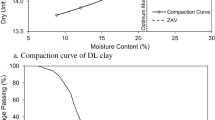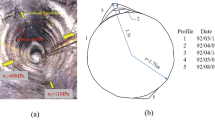Abstract
Understanding water migration in soil specimens under triaxial test conditions is of great significance for investigating the mechanism of distress in railway subgrades. However, the water content distribution along the specimen height is difficult to determine with current equipment. Motivated by such limitations, we developed an apparatus relying on the van der Pauw principle, to measure the water content based on the specimen’s electrical properties. Additionally, a series of exploratory tests on unsaturated soil specimens were conducted to evaluate the performance of this apparatus. To verify the practicability of the apparatus, a water-supply dynamic triaxial test was also carried out with an unsaturated dynamic triaxial test system (GDS). The results indicate that this apparatus is stable, as the measurement accuracy is not influenced by the electrode position or the soil geometry or dimensions. In a narrow triaxial pressure chamber, this apparatus can be used to determine the distribution of water content in unsaturated specimens nondestructively and consecutively during a triaxial test. The maximum error obtained from the apparatus when measuring the gravimetric water content was 0.7%. The soil resistivity calculation function was obtained considering the dry density and gravimetric water content with high correlation and precision. This apparatus has broad applications for investigating the mechanism of water migration within some geotechnical materials.




















Similar content being viewed by others
References
Abdellaoui H, Zaourar N, Kahlouche S (2019) Contribution of permanent stations GPS data to estimate the water vapor content over Algeria. Arab J Geosci 12(3):81–94
Abidin M, Saad R, Ahmad F et al (2014) Correlation analysis between field electrical resistivity value (ERV) and basic geotechnical properties (BGP). Soil Mech Found Eng 51(3):117–125
Alabi A, Akinyemi O, Olowofela J et al (2018) Estimation of ground water content using water balance and regression approach. Arab J Geosci 11(21):659–674
Archie G (1942) Electrical resistivity an aid in core-analysis interpretation. AAPG Bull Am Assoc Pet Geol 31(2):350–366
ASTM (2012) G57-06-2012. America society for testing and materials, standard test method for field measurement of soil resistivity using the WENNER four-electrode method[S].
Banaszczyk J, Schwarz A, Mey G et al (2010) The Vander Pauw method for sheet resistance measurements of polypyrrole-coated para-aremide woven fabrics. J Appl Polym Sci 117(5):2553–2558
Burger H, Burger D (1992) Exploration geophysics of the shallow subsurface[M]. Upper Saddle River, Prentice Hall
Corwin D, Lesch S (2005) Apparent soil electrical conductivity measurements in agriculture. Comput Electron Agric 46(1/2/3):11–43
Ferre P, Redman J, Rudolph D et al (1998) The dependence of the electrical conductivity measured by time domain reflectometry on the water content of a sand. Water Resour Res 34(5):1207–1213
Grysinski T, Moron Z (2011) Planar sensors for local conductivity measurements in biological objects-design, modelling, sensitivity maps. Sensors Actuators B Chem 158(1):190–198
Han L, Liu S, Du Y (2006) New method for testing contaminated oil-electrical resistivity method. Chi J Geotech Eng 28(8):1028–1032
Islam T, Chik Z, Mustafa M et al (2012) Modeling of electrical resistivity and maximum dry density in soil compaction measurement. Environ Earth Sci 67(67):1299–1305
Kibria G, Hossain M (2012) Investigation of geotechnical parameters affecting electrical resistivity of compacted clays. J Geotech Geoenviron Eng 138(12):1520–1529
Lee J, Shang J, Lee J et al (2011) Influencing factors on electrical conductivity of compacted kaolin clay. Geomech Eng 3(2):131–151
Liu G, Wang Z, Huang J (2004) Research on electrical resistivity feature of soil and its application. Chin J Geotech Eng 26(1):83–87
Moron Z (2003) Investigations of van der Pauw method applied for measuring electrical conductivity of electrolyte solutions: measurement of electrolytic conductivity. Measurement 33(3):281–290
Muno-zcastelblanco J, Pereira J, Delage P et al (2013) The influence of changes in water content on the electrical resistivity of a natural unsaturated loess. Astm Geotech Test J 35(12/13):1927–1934
Nahlik J, Kasparkova I, Fitl P (2011) Study of quantitative influence of specimen defects on measurements of resistivity of thin films using van der Pauw method. Measurement 44(10):1968–1979
Nahlik J, Kasparkova I, Fitl P (2013) Influence of non-ideal circumferential contacts on errors in the measurements of the resistivity of layers using the van der Pauw method. Meas J Int Meas Confederation 46(2):887–892
Preis W (2015) Modelling of surface exchange reaction, oxygen diffusion, and conductivity relaxation of solid oxides: application to the van der Pauw method on disk-shaped specimens. Comput Mater Sci 103(6):237–243
Rakorenko N, Korotchen T (2016) Impact of petroleum products on soil composition and physicochemical properties. Earth Environ Sci 33(1):012028
Singh D (2004) Measuring soil electrical resistivity using a resistivity box and a resistivity probe. Geotech Test J 27(4):496–497
Son Y, Oh M, Lee S (2009) Estimation of soil weathering degree using electrical resistivity. Environ Earth Sci 59(6):1319–1326
Vander P (1958) Method of measuring specific resistivity and hall effect of diks of arbitrary shape. Phil Res Rev 13:1–9
Wychowaniak D, Zawadzki L, Lech M (2015) Application of column tests and electrical resistivity methods for leachate transport monitoring. Ann Wars Univ Life Sci Land Reclam 47(3):237–247
Yu X, Liu S (2004) Researches on application of electrical resistivity indices to the microstructure of expansive soils. Chin J Geotech Eng 26(3):393–396
Zha F, Liu S, Du Y et al (2008) Quantitative research on microstructures of expansive soils during swelling using electrical resistivity measurements. Chin J Geotech Eng 30(12):1832–1839
Zha F, Liu S, Du Y et al (2010) Prediction of matric suction of unsaturated soil based on electrical resistivity. Rock Soil Mech 3:1003–1008
Zhou W, Lee M (2010) A detector for plant electrical conductivity based on four-electrode method. Sens Lett 8(1):122–127
Zhou Z, Zheng L, Sun B (2009) Research on relationships between water content and resistivity of earthen ruin walls. Chin J Rock Mech Eng 28(S2):4054–4058
Zhou M, Wang J, Cai L et al (2015) Laboratory investigations on factors affecting soil electrical resistivity and the measurement. IEEE Trans Ind Appl 51(6):5358–5365
Funding
This research was funded by the National Natural Science Foundation of China under grant no. 51178281, the Natural Science Foundation of Hebei Provence under grant no. E2015210006, and the Doctoral Research Funding Project of Hebei Province under grant no. CXZZBS2017134.
Author information
Authors and Affiliations
Corresponding author
Additional information
Responsible Editor: Zeynal Abiddin Erguler
Rights and permissions
About this article
Cite this article
Yang, Z., Yue, Z., Sun, T. et al. An apparatus for measuring water content of unsaturated soil based on the van der Pauw principle. Arab J Geosci 13, 259 (2020). https://doi.org/10.1007/s12517-020-5248-5
Received:
Accepted:
Published:
DOI: https://doi.org/10.1007/s12517-020-5248-5




